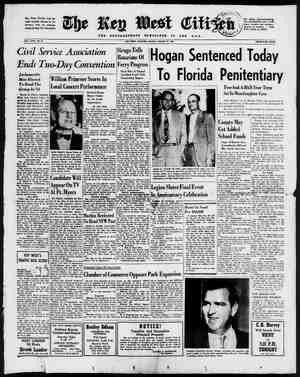The Key West Citizen Newspaper, March 19, 1954, Page 10
You have reached the hourly page view limit. Unlock higher limit to our entire archive!
Subscribers enjoy higher page view limit, downloads, and exclusive features.
Making a broom is an intricate operation for tiny Hansel., n a downtown New York motion picture studio, more than @ | score of inanimate actors are putting on a slow motion pere formance of ‘‘Hansel and Gretel’’ that would do credit to human showfolk. They will be seen on the screen sometime next spring. The ‘‘stars’’-are singing, dancing, acting dolls which have ad- vanced beyond the roles of ordinary puppets or marionettes. They are mechanically and electrically operated. It took their creator, Michael Myerberg, 15 years to develop them. They cost upward of $2500 each. The little figures are versatile. Their armatures, or skeletons, duplicate very closely the movements of human beings. Their limbs can be locked in any position. They're moved by animators on magnetized stages and photographed one frame at a time. Approximately 117,000 single photographs will make up the 78- minute film. For closeups, the heads are operated electronically. Twelve separate calibrated dials enable the operator to move the face automatically in any one of thousands of expressions. ‘ wd x a = iS % Chemist Isidor Rosenblatt grinds up one of jelly components of Mold maker Byron Baer removes a cat from the mold. Secret mixture which serves as the figure's life-like skin. The animal will be seen in ‘‘Hansel and Gretel.’’ Hansel and Gretel are in the skeleton stages. Larry Johnson, left, Prepares a plastic skull for mounting. Model maker Al Abram- owitz,right, assembles a figure which will be Gretel. In background, workers are busy at a lathe and drill press. <a It’s a busy studio, as Herb Schaeffer checks camera fo- cus and animator Danny Diamond positions Gretel. Animation director Nathalie Schulz keeps ‘‘score’’ on production sheet,

